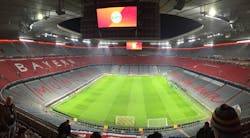Our offices are closed from Christmas Eve into the New Year, so I’m technically not working. What better time to sneak in a story that doesn’t really have anything to do with manufacturing? No, I take that back. Although the application centers on a soccer stadium, it shows off what any operation can achieve by leveraging cutting-edge sensors, cloud computing and—not to be discounted—conversations with the person who’s actually going to be using the technology.
A recent trip to Munich, Germany, was geared largely toward showing U.S. industry journalists what the Charter of Trust partners have been doing to develop a cyber environment more worthy of the trust required for the Industrial Internet of Things (IIoT). But Siemens also gave us a night to enjoy a Champions League soccer game played at the stadium named for one of its Charter of Trust partners: Allianz.
Besides being the home field for FC Bayern—the indisputable dominant force of the Bundesliga (OK, some might like to dispute that, but they are the league champions, after all, and have won more championships [27] than any other team [and are also my son’s favorite, which is reason enough for my assertion])—Allianz Arena also has an impressive arsenal of technology at the ready. Siemens has a strong technology partnership with Allianz Arena that includes energy, building infrastructure, mobility and security.
The stadium’s new video wall (the largest in Europe) quadruples the energy consumption of the previous video wall. Energy for the stadium is currently supplied through two municipal transformer stations; future plans for what equals the energy consumption of a small town on match day include a complete microgrid solution by Siemens. Siemens is also involved with camera and video surveillance systems for both traffic management on nearby motorways and security in and around the stadium.
Sensor in the grass
But one of the coolest technologies showcased at Allianz Arena makes use of MindSphere (Siemens’ open IoT operating system) and software developed by Siemens subsidiary evosoft to help the greenskeeper take better care of the soccer field. Four boxes placed on the grass when play is not underway use an array of sensors to gather data—on things like light, temperature, humidity, wind, salt content, chlorophyll content—which is sent to the cloud and evaluated. Data from the playing field is delivered to the collector box once per minute, and current weather data and forecasts are also fed into MindSphere.
What the groundskeeper made clear to the developers from the get-go was that he really wanted an interpretation of the data coming from the sensors, said Lars Oyntzen, business intelligence consultant for evosoft.
MindSphere evaluates the data, formulates action recommendations, and converts both into clear diagrams. The FC Bayern Greenkeeper App—which the greenskeeper can check via his smartphone—provides specific action recommendations: water more; expose the grass to stronger or longer light; start the lawn heating or turn it down.
FC Bayern’s expert groundskeeper might never give up his early morning visits to the pitch to see first-hand how his turf is faring. But the new app could be particularly helpful for what he considers his main pain point: fungal diseases. Fungus spreads quickly and can be devastating to a field. The cost to replace the grass can run into the hundreds of thousands of euros, and the prospect of having to replace the entire field right before match day—as FC Bayern had to do about two years ago—is one nobody wants to face.
The greenskeeper only knows if there’s a fungus problem if he can see it, Oyntzen said. “You have to be quick or it will spread,” he explained. “He really wants a way to recognize it before it’s happening.”
MindSphere can connect the data to the cloud to calculate the current state of the pitch. With this information, Siemens and evosoft are trying to provide a forecast on diseases that could give the greenskeeper as much as four or five days of advanced warning, Oyntzen said.
Emotional data
Though the greenskeeper might get emotional about the state of his field (I really can’t say), there’s no question that soccer fans in Europe get more than a little emotional about The Beautiful Game. Siemens thought it would be cool to use data not only to provide concrete recommendations, as above, but also to find a way to capture and visualize human emotion.
Teaming with FC Bayern again, Siemens is using cutting-edge data visualization to map the energy of the fans inside Allianz Arena. “We want to use data to tell an emotional story,” said Johanna Prestele, communications manager, campaigns, for Siemens. “We see post-game analytics, but we never see analysis of the data that the fans create—when they cheer for the 90 minutes of the game.”
Working with the Economist’s data visualization agency Signal Noise, Siemens got highly accurate laser scans of Allianz Arena to create a 3D model. During the 2018-19 season, acoustic sensors are being used to capture sound data at FC Bayern home games. The data is laid over the 3D model to create a heat map that tells the story of fan energy at the matches.
Siemens is trying to transmit the feeling of being in the arena, according to Prestele, who added that Bayern fans said they got goosebumps from seeing the stadium’s story told in such a way. Definitely some interesting technology, and I’ll be interested to see where they go with it. But for me, I’ll take the goosebumps I got actually watching FC Bayern beat Portugal’s SL Benfica 5-1.

